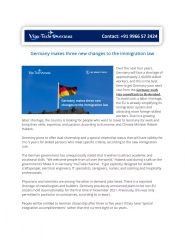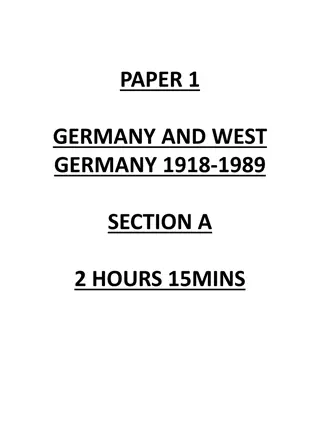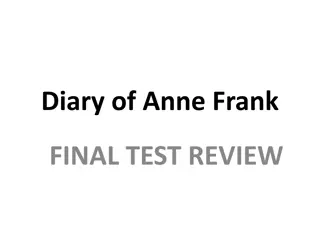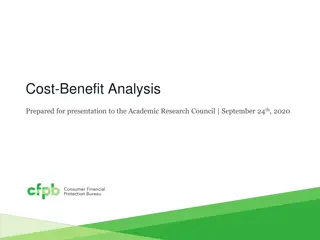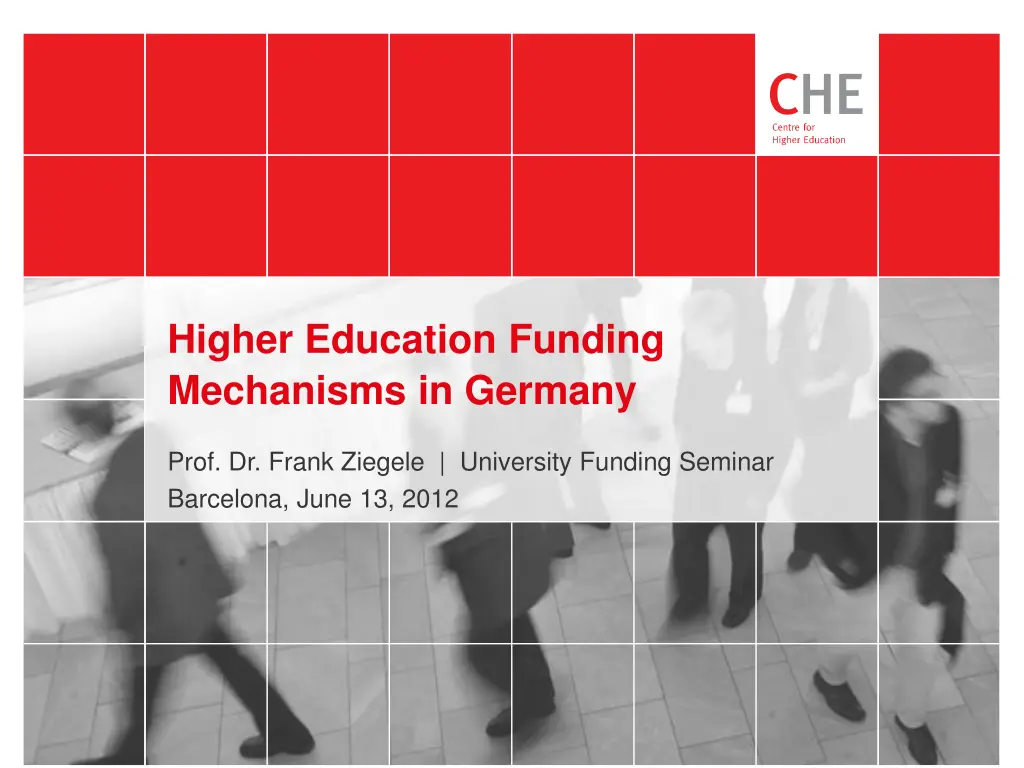
Understanding Higher Education Funding Mechanisms in Germany
Explore the intricacies of higher education funding in Germany, as discussed by Prof. Dr. Frank Ziegele at a university funding seminar in Barcelona. Learn about the state funding mechanisms, political contexts, and public funding models that shape funding strategies for universities and Fachhochschulen in Germany.
Download Presentation

Please find below an Image/Link to download the presentation.
The content on the website is provided AS IS for your information and personal use only. It may not be sold, licensed, or shared on other websites without obtaining consent from the author. If you encounter any issues during the download, it is possible that the publisher has removed the file from their server.
You are allowed to download the files provided on this website for personal or commercial use, subject to the condition that they are used lawfully. All files are the property of their respective owners.
The content on the website is provided AS IS for your information and personal use only. It may not be sold, licensed, or shared on other websites without obtaining consent from the author.
E N D
Presentation Transcript
Higher Education Funding Mechanisms in Germany Prof. Dr. Frank Ziegele | University Funding Seminar Barcelona, June 13, 2012
Agenda The context Outlines of the funding system Mechanisms of state funding Some figures on funding Lessons learnt Higher Education Funding Mechanisms in Germany | Frank Ziegele | June 13, 2012 2
The German funding model is of course not independent from (political) contexts. federal system, state responsibility, 16 systems change in steering paradigms: new public management specific roles of federal government: projects of national relevance, student support specific demographic development political objectives: research excellence strong non-university research sector Universities and Fachhochschulen (universities of applied sciences) Higher Education Funding Mechanisms in Germany | Frank Ziegele | June 13, 2012 3
Agenda The context Outlines of the funding system Mechanisms of state funding Some figures on funding Lessons learnt Higher Education Funding Mechanisms in Germany | Frank Ziegele | June 13, 2012 4
Public funding models in Germany try to balance three major purposes. guarantee basic funding, stability, autonomy, multi- period planning horizons create competition, ex post rewards/sanctions, performance orientation BALANCE induce targeted incentives, promote strategies/profiles, ex ante funding of innovations + excellence Higher Education Funding Mechanisms in Germany | Frank Ziegele | June 13, 2012 5
The balancing in a federal system leads to complexity of public funding sources. Federal government (3 billion ) 16 state governments (20 billion ) focus research project funding, DFG 20% overhead matching funds federal programs higher education pact institutional funding project funding excellence initiative research Deutsche Forschungs- gemeinschaft (DFG) competitive targeted funding (e.g. teaching quality) research project funding higher education institutions Higher Education Funding Mechanisms in Germany | Frank Ziegele | June 13, 2012 6
The excellence initiative leads to focused investment in world-class research (peer- review based). future excellence plans of institutions graduate schools research clusters qualifies collaboration (incl. non- university research) international competitiveness interdisci- plinary cooperation young + world-class researchers involved all fields Higher Education Funding Mechanisms in Germany | Frank Ziegele | June 13, 2012 7
The Higher Education Pact leads to a nation-wide money follow student funding element. background: student high (demographics, participation) additional students compared with 2005 (plan: 91.000 until 2010) allocation: planned expansion (ex ante) + real student numbers (ex post) political decisions + real performance quick money leads to flexibility, very effective (in fact 182.000 additional students until 2010) limited to bachelor level, master level neglected (short-sighted policy) Higher Education Funding Mechanisms in Germany | Frank Ziegele | June 13, 2012 8
The state institutional funding models are diverse, but with some common ground. framework contract financial model Deregu- lation univ. revenues: goal-oriented funding, 3-pillars-model university expenditures: lump-sum budgeting state objectives accountability, KPI Higher Education Funding Mechanisms in Germany | Frank Ziegele | June 13, 2012 9
The 3-pillar model is more or less implemented in all German states. steering objectives influence behavior incentives for performance rewards for past performance finance innovation in advance control result of innovation promises on future performance cost orientation ability to fulfill tasks stability stable planning horizon ratio- nale basic, task- oriented funding performance- oriented funding innovation- oriented funding + + 3 pillars differences in weights, instruments used, (identification of 3 types in Germany) Higher Education Funding Mechanisms in Germany | Frank Ziegele | June 13, 2012 10
Agenda The context Outlines of the funding system Mechanisms of state funding Some figures on funding Lessons learnt Higher Education Funding Mechanisms in Germany | Frank Ziegele | June 13, 2012 11
The three-pillar-model exists more or less in all the states, but with differences. Type 1 combines history + performance. performance- oriented funding innovation- oriented funding + + basic funding historical budget staff-oriented will change if staff plan changes sometimes general deal (lump sum + strategies/ targets in a general contract) substantial element of formula funding specific programs Higher Education Funding Mechanisms in Germany | Frank Ziegele | June 13, 2012 12
A good example for type 1 is Lower Saxony. basic funding (with general deal contract, list of topics to be covered) some innovation programs (small budgets, for instance family orientation, humanities program, internationalization program competitive funds) performance budget (formula with indicators, 10 %) task indicator share Teaching 48 % first semester students 21 % graduates (weighted according to study duration) 75 % incoming students 2 % outgoing students 2 % typical set of indicators Research 48 % research income 74 % Ph.Ds 24 % Humboldt stipends 2 % Gender equality 4 % newly appointed female profs 40 % female graduates 20 % female Ph.Ds 20 % Higher Education Funding Mechanisms in Germany | Frank Ziegele | June 13, 2012 13
The size of the performance-oriented pillar varies between the states. > 20 %: Berlin, Rhineland- Palatinate, Thuringia 0 %: Bremen, Saxony- Anhalt, Saarland 3 states 3 states 3 states 7 states 0-5 %: Bavaria, Saxony, Schleswig-Holstein 5-20 %: Hamburg, Baden-W rttemberg, Brandenburg, Hesse, Mecklenburg-Western Pomerania, Lower Saxony, North Rhine- Westphalia Higher Education Funding Mechanisms in Germany | Frank Ziegele | June 13, 2012 14
Type 2 is an indicator-dominated model with basic formula funding. number of students or professors field-specific price per student/professor research included in price students vs. professors: balance between supply- and demand-orientation mechanisms of stabilization (loss caps, multi-year averages) often integrated model for universities and Fachhochschulen basic funding Higher Education Funding Mechanisms in Germany | Frank Ziegele | June 13, 2012 15
A good example for type 2 is Berlin. comprehensive price model: integrated model for demand-oriented basic funding and performance-orientation basic funding price, examples ( ) (31 %) humanities (university), per student 13.000 engineering (university), per student 24.000 engineering (FH), per student 18.000 arts (university), per student 43.000 research rewards, examples ( ) (31 %) third-party-funding (per 1.000 ) 500 participation graduate school (per school) 300.000 Ph.Ds (university) 25.000 regional cooperation contracts (FH) 25.000 gender/ diversity rewards, examples ( ) (4 %) newly appointed female professors up to 70.000 female Ph.Ds 10.000 first semester students with migration background 10.000 the same in teacher education 25.000 Higher Education Funding Mechanisms in Germany | Frank Ziegele | June 13, 2012 16
Berlin shows the potential virtues and problems of price models. + dynamics in overall budget development performance increase is no zero-sum game until 2013: HEI could earn up to 73 Mio more if they increase their performance - fixed budget limit, finance minister will not accept total flexibility frustration if price cutbacks are necessary Higher Education Funding Mechanisms in Germany | Frank Ziegele | June 13, 2012 17
Type 3 is a negotiation model. The major instrument is the target agreement/ performance contract. performance- oriented funding innovation- oriented funding + + basic funding contracts with negotiated student numbers (Hesse) negotiated numbers of graduates (Hamburg) performance goals (quantified), sanctions (Saarland) minor role target agreements on profile-oriented projects measurable goals funding according to aspiration + attainment of objectives example: North Rhine-Westphalia Higher Education Funding Mechanisms in Germany | Frank Ziegele | June 13, 2012 18
Performance contracts are a major innovation in HE funding, but their success depends on their design. Good performance contracts have to implement a structured bottom-up-top-down dialogue. include the requirement to develop SMART goals. relate performance measurement to profiles and strategies. run for more than 1 year (with possibilities to adapt). set priorities instead of listing everything a university does. methodological knowledge from German experience example Croatia Higher Education Funding Mechanisms in Germany | Frank Ziegele | June 13, 2012 19
Agenda The context Outlines of the funding system Mechanisms of state funding Some figures on funding Lessons learnt Higher Education Funding Mechanisms in Germany | Frank Ziegele | June 13, 2012 20
Excellence initiative, higher education pact and institutional funding Hochschulpakt 2020 S ule I (3,09%) Exzellenzinitiative (1,84%) Grundmittel d. L nder (ohne Hochschulpakt- Eigenbeteiligung) (95,06%) excellence initiative ( ) 2011 2012 2013 2014 2015 2016 2017 2 27,1 Mio 215,1 483,9 502,6 530 525 440 2006 190 Mio. 2007 380 2008 380 2009 380 2010 380 2011 190. 1 Higher Education Funding Mechanisms in Germany | Frank Ziegele | June 13, 2012 21
Institutional funding per student in the 16 states Source: Hochschulen auf einen Blick. Statistisches Bundesamt 2012 Higher Education Funding Mechanisms in Germany | Frank Ziegele | June 13, 2012 22
Institutional state funding vs. third-party funding Higher Education Funding Mechanisms in Germany | Frank Ziegele | June 13, 2012 23
Agenda The context Outlines of the funding system Mechanisms of state funding Some figures on funding Lessons learnt Higher Education Funding Mechanisms in Germany | Frank Ziegele | June 13, 2012 24
Lessons learnt There is no one-size-fits-all solution. It depends on size of the state, negotiation culture, data quality, historical differences etc. The use of indicators stimulates discussions and transparency, has incentive effects, even if distributed funds are low. HEI appreciate the individualization of performance measurement through target agreements. Higher Education Funding Mechanisms in Germany | Frank Ziegele | June 13, 2012 25
Lessons learnt But target agreements could be dangerous (dangers for autonomy, bureaucracy, inflexibility ), yet the right methods could avoid this. A combination of formula funding and target agreements has advantages (for instance rewards + pre-funding, efficiency + focused discussions). Negative impact of indicators on quality is often assumed, but there are no proofs. Higher Education Funding Mechanisms in Germany | Frank Ziegele | June 13, 2012 26
Lessons learnt Typical frustrations occur because of zero-sum games, discretionary political funding, vicious circles. Isolated development of funding systems is problematic, close link to autonomy, reporting, competences for internal allocation has to be taken into account. Technical issues matter (formula construction, guidelines for performance contracts, processes etc.). Higher Education Funding Mechanisms in Germany | Frank Ziegele | June 13, 2012 27
Thank you for your attention! frank.ziegele@che.de







